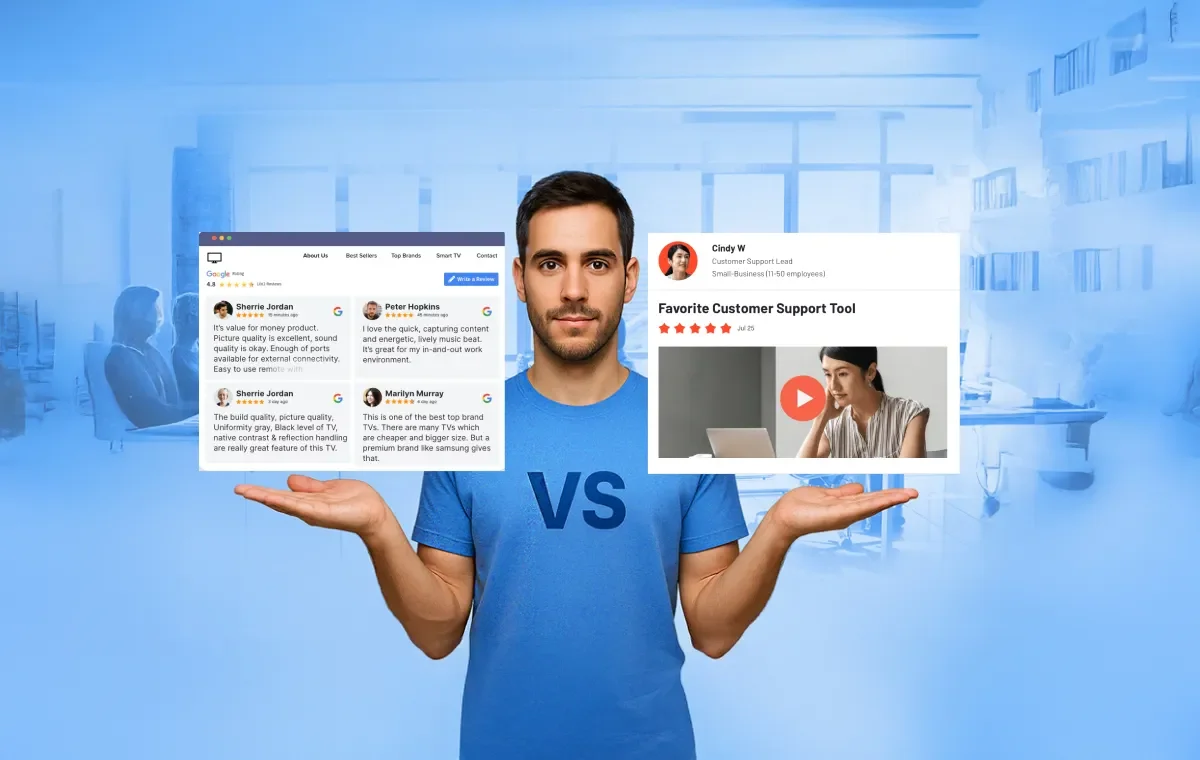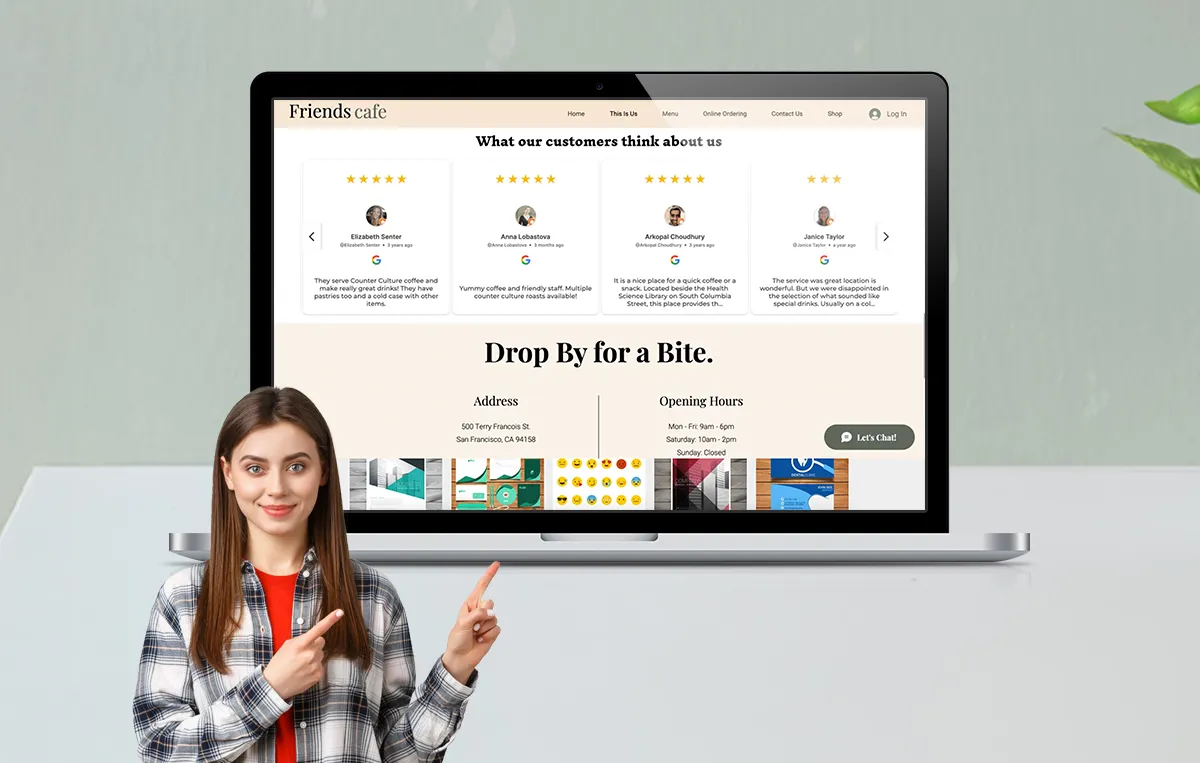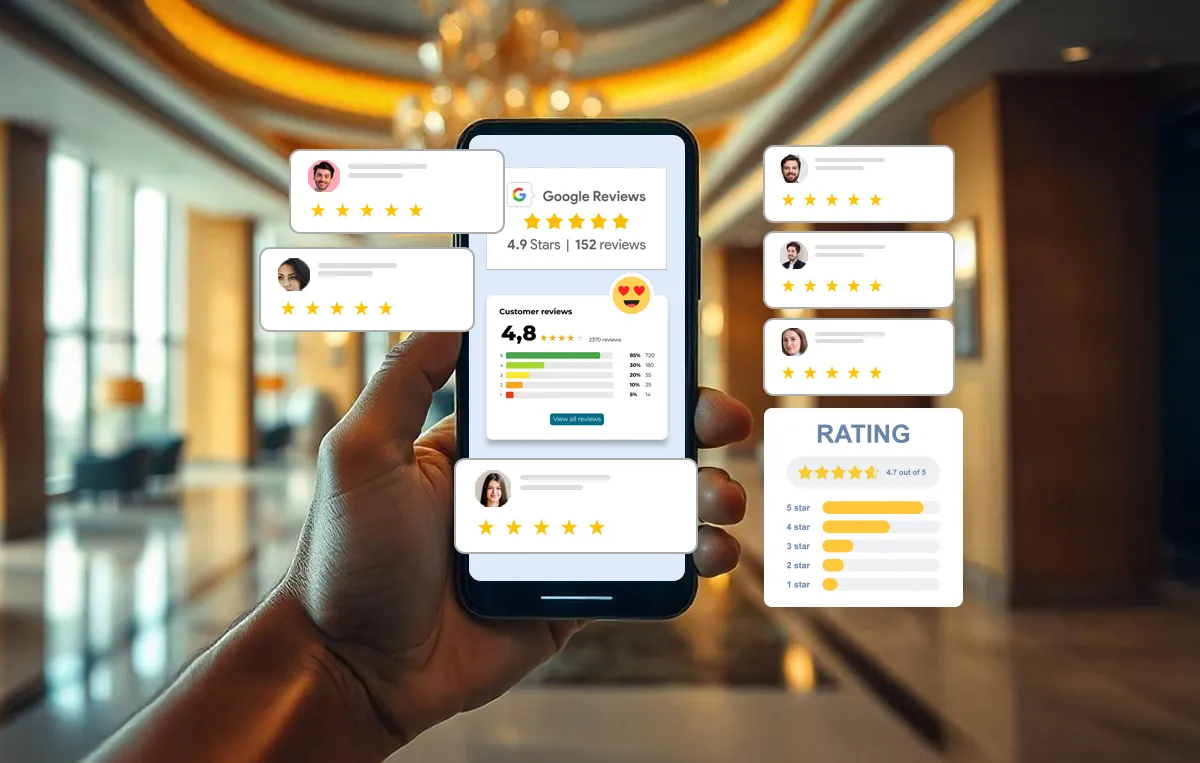Customer feedback is crucial, and this fuels trust in your business. However, not all feedback serves the same purpose. Confusing testimonials with reviews can blur your messaging and weaken your credibility. You may also miss some key conversion opportunities.
This is why understanding the difference between a testimonial and a review is crucial, as it helps you leverage them both for optimal credibility and conversions.
Testimonials are curated stories that shine a spotlight on success. Reviews are raw, real-time opinions from everyday users. Both serve a purpose, and when used strategically, they can literally transform how people perceive your business.
In this guide, we’ll break down their key differences and show you how SocialPilot makes it easy to manage, display, and leverage both to grow your brand online.
What is a Testimonial?
A testimonial is basically “a statement testifying to benefits received” or “a character reference: letter of recommendation.” This is what the Merriam-Webster Dictionary says. Simply put, it is someone vouching for something (could be a product or a service) based on their personal experience.
Compared to a review, a testimonial is often detailed. Additionally, it is given directly by a customer to a company without the interference or involvement of any third party.
In a world overflowing with choices, testimonials act as guiding stars.
Why’s that? Because they provide real-life insights and help build trust. When we hear others raving about something, we’re more inclined to give it a shot.
It’s human nature to seek social proof and validation before making decisions, and testimonials provide us with just that.
Here are some of its features:
- They talk about real-life experiences, making them seem genuine and relatable.
- They highlight the benefits or positive outcomes and offer in-depth insights into customer experiences.
- They’re usually written or spoken in the customer’s own words and may also include videos, pictures, etc. Video testimonials, in particular, add a layer of authenticity, making them more persuasive and relatable.
- They serve as evidence of a good customer experience, boost business credibility, and are often persuasive.
- Testimonials are often displayed to make potential customers feel more confident about their choices.
So, the next time someone talks about their favorite coffee or appreciates quick service at your coffee shop, remember that they are giving you a testimonial!
The image below shows testimonials for the coffee shop Mozart Coffee, displayed on their website.

What is a Review?
According to the Merriam-Webster Dictionary, a business review is “a critical evaluation or analysis of a business, typically involving its products, services, or operations.” Simply put, it’s all about people sharing their genuine experiences, but on third-party review sites.
Unlike testimonials, which are often shared directly with the business, online reviews are meant for the public eye. They are shared on review platforms like Google, Yelp, TripAdvisor, or even niche sites related to specific industries.
The image below shows Google reviews for Mozart Coffee Roasters; unlike testimonials, these are raw and recent, providing prospective visitors with honest customer feedback.
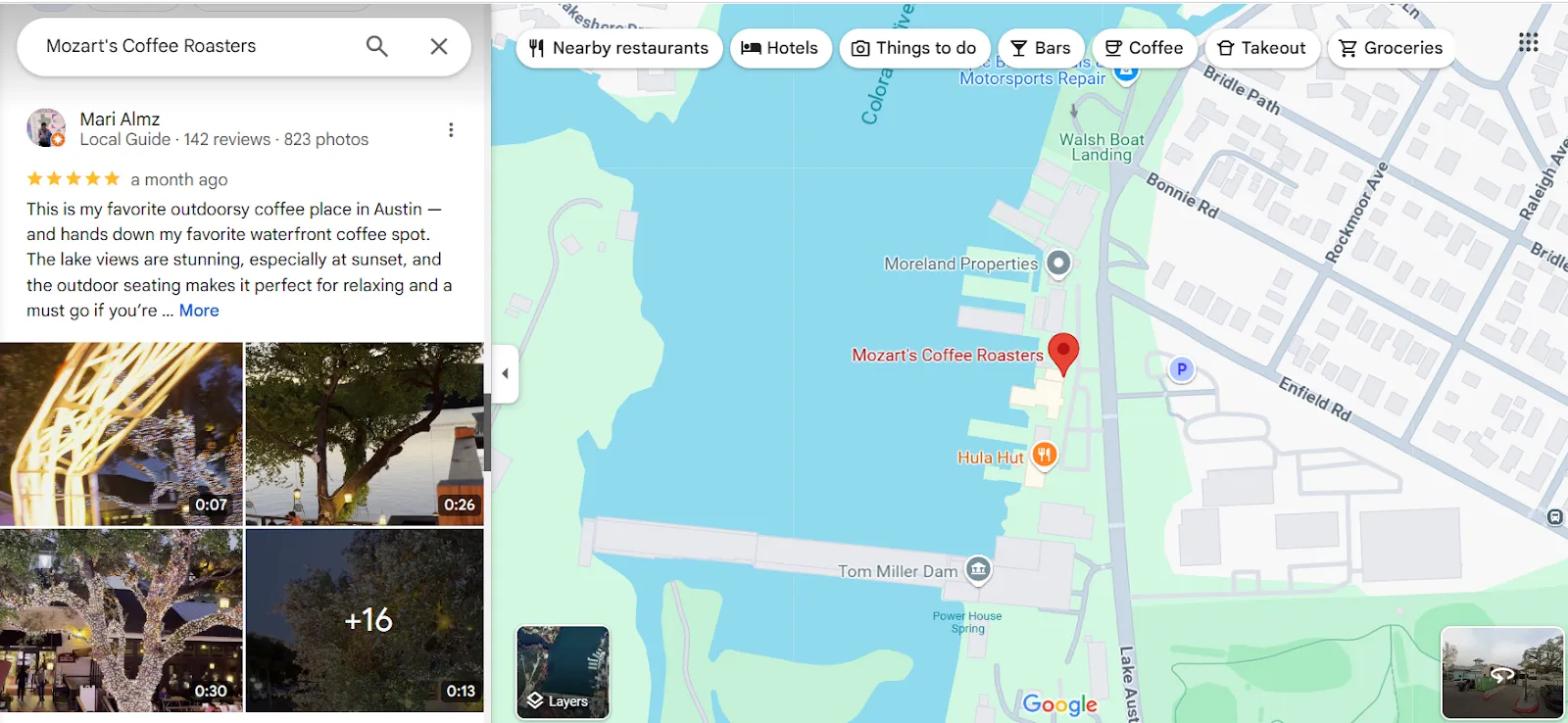
Positive reviews can greatly shape people’s purchase decisions, as 98% of customers read business reviews before visiting a local business.
Here are some features of a review:
- They’re written by customers (or, at least, they should be!) and are shared on platforms like Google, Yelp, or Facebook.
- Reviews are unfiltered public opinions and can be both positive and negative.
- Often, there is also an associated rating system – usually from 1 to 5 stars.
- They come from real customers and touch upon multiple aspects like product/service quality, pricing, performance, staff behavior, and more.
- Reviews are often timestamped, so readers know how recent or relevant it is.
Key Differences Between Testimonials & Reviews
While both reviews and testimonials depict your brand’s connection with its customers, there are some significant differences between the two in terms of structure, length, and tone.
They also have different functions in a brand’s trust-building strategy and are often used at different stages of a brand’s marketing strategy. Understanding these differences will help you make informed decisions as to how and when to use testimonials and reviews to support your buyer’s journey.
Let us now dive into these differences.
1. Source
A testimonial is generally something that a business requests- they don’t just happen. Companies tend to reach out to customers they know had a good experience and ask them to share their feedback.
The idea here is to use the positive narratives and convert them into trust signals for the prospective ones.
Reviews, on the other hand, are usually written by customers out of their own free will. So, if I use a software for long and I strongly feel like sharing my opinion, whether it’s good or bad, I can go to a third-party review website like G2 and leave a brand review.
These are unfiltered and uncontrolled public opinions on public platforms, where anyone can read them.
2. Tone and Sentiment
The tone of testimonials is mostly (if not always) positive. They tend to be longer, more formal, and emphasise praise, successful outcomes, and customer satisfaction because they are carefully selected and frequently modified in conjunction with the client.
Reviews, on the other hand, are shorter, more informal, balanced, and diverse. They offer the customer’s unbiased opinion and talk about both the good and the bad. They are impartial, critical, or complimentary. As a result, they are especially helpful to customers looking for honest, unbiased reviews.
3. Level of Control
Businesses can greatly control their testimonials; they can also decide which ones to publish and suggest edits or changes in the language, tone, etc.
Reviews are beyond the control of the brand, because these are generally published on their own accord on the review sites, and businesses are not allowed to remove or edit them. They can, however, respond publicly or flag bad content, but the underlying message in the review remains intact.
4. Placement and Visibility
Testimonials are mostly placed on a brand’s own website, their product brochures, email campaigns, landing pages, and social media pages. They are purposefully placed, typically close to pricing tables, service descriptions, or calls to action to enhance buyers’ confidence.
The image below shows SocialPilot testimonials on their website’s home page.
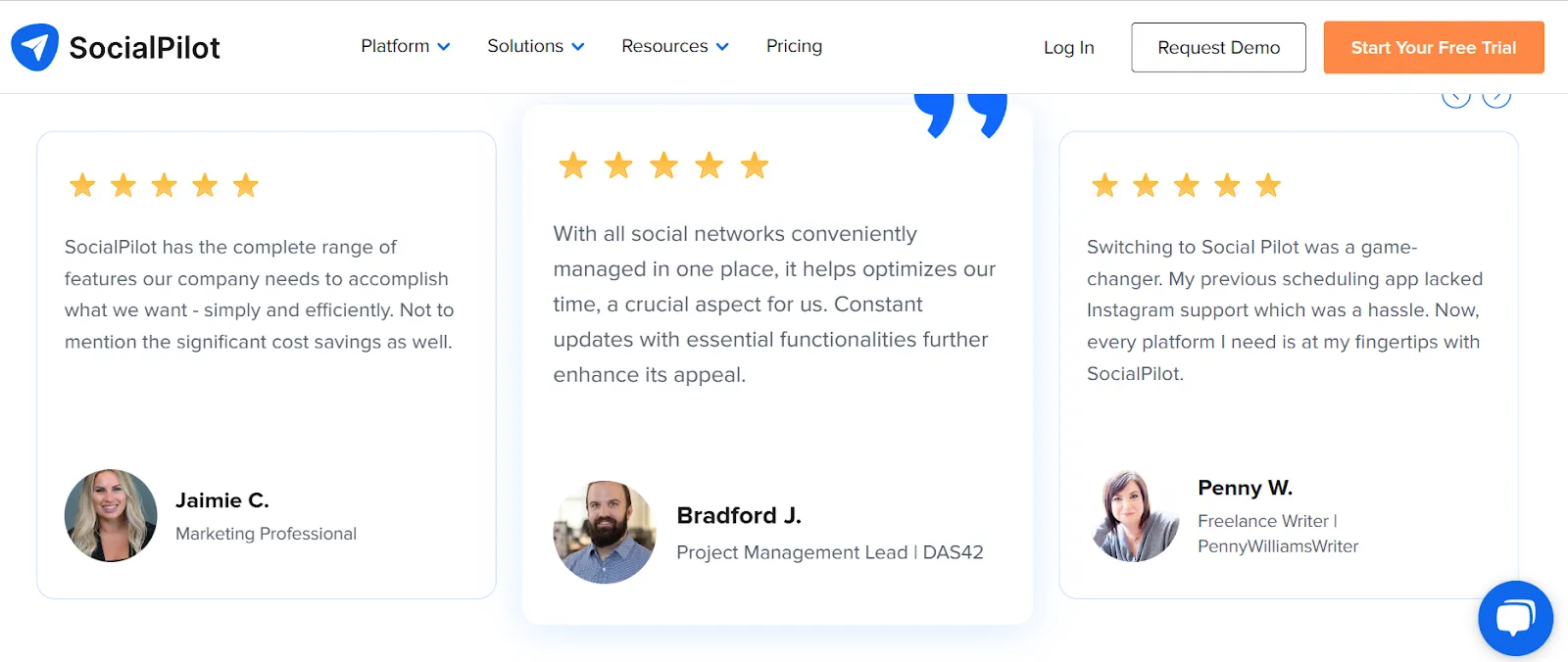
Reviews, as we know, are on third-party sites, usually where potential buyers first start their product search. They play an important role in shaping how customers perceive your products because they are unbiased and have a wide audience.
The image below shows the SocialPilot reviews on G2.
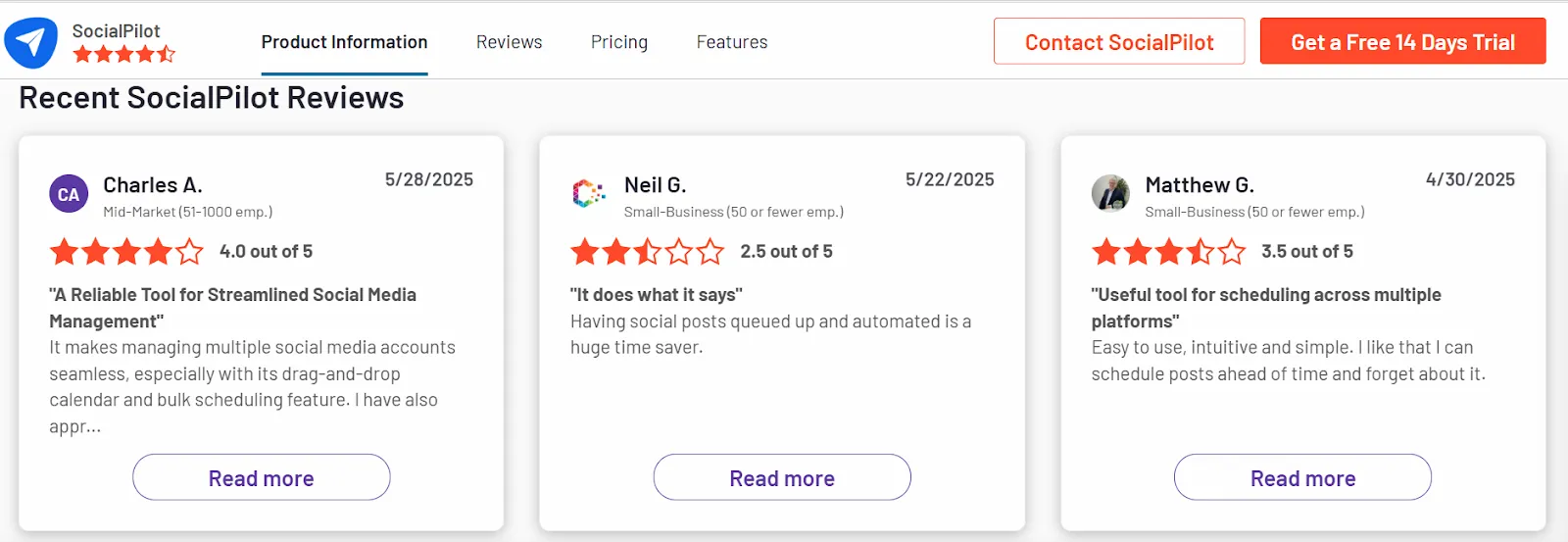
5. Purpose and Intent
The main goal of a testimonial is to build trust by sharing real success stories. When done right, they highlight what went well, the results achieved, and how the customer actually felt about the experience.
Reviews, however, reflect unfiltered, real-time feedback from everyday customers. Their authenticity makes them a cornerstone of trust and a key driver of review marketing, where brands leverage public opinion to influence buyer decisions across multiple touchpoints.
6. Influence on the Buyer Journey
Testimonials help buyers during the contemplation or decision-making phase. Seeing the success stories of previous customers might allay any remaining uncertainties in a prospect who is on the verge of making a buy but wants some assurance.
Reviews are especially helpful in the early stages of the buyer journey, like awareness and research. Shoppers often start by scanning reviews to get a sense of the product’s performance, brand reputation, and customer satisfaction. It’s how they filter their options and decide who’s worth a deeper look.
7. Impact on SEO
While testimonials don’t directly boost SEO, they can still support your overall strategy. By increasing on-site engagement, time spent on page, and conversion rates, they send positive user signals to search engines, indirectly contributing to better performance.
Reviews have a far more direct impact on SEO, particularly for local businesses. Local search rankings are directly impacted by platforms such as Google Reviews. A steady stream of reviews can enhance visibility, improve click-through rates, and strengthen trust signals, making them essential for local SEO success.
While reviews help your prospective customers build trust in you, testimonials are best suited for reinforcing that trust.
By understanding their individual roles, businesses can create a more complete and effective marketing strategy that helps them get and convert their leads.
| Aspect | Testimonial | Review |
| 1. Source | Requested by the business from satisfied customers. Carefully curated to highlight positive experiences. | Written voluntarily by customers on public platforms like G2 or Google. Unfiltered and not influenced by the business. |
| 2. Tone and Sentiment | Mostly positive, formal, and success-focused. | Informal, concise, and unbiased. May be positive, negative, or neutral. |
| 3. Level of Control | Highly controlled by the business. They choose what to publish and may edit for clarity, tone, or length. | No control. Brands cannot alter or delete them, though they may respond or flag inappropriate content. |
| 4. Placement and Visibility | Typically placed on the brand’s website, brochures, emails, landing pages, social media; near CTAs or pricing to build confidence. | Found on third-party platforms (e.g., Google, G2, Yelp) where customers begin their research. |
| 5. Purpose and Intent | To build trust by showcasing real success stories and highlighting outcomes. | To share honest, real-time feedback. Helps in forming perceptions and guiding decisions. |
| 6. Influence on Buyer Journey | Most effective in the decision-making phase. | Useful in the early research or awareness phase. |
| 7. Impact on SEO | Indirect SEO impact – boosts user engagement, time on page, and conversions on the brand’s site. | Direct SEO impact, especially for local SEO. Improves search visibility, click-through rates, and trust signals. |
Let us now understand why a business needs a balance of both: testimonials and reviews.
Why Both Testimonials & Reviews Matter for Your Business
In today’s trust-driven marketplace, both testimonials and reviews are essential. In fact, most smart brands don’t see testimonial vs review as an either-or choice. They understand how each customer feedback builds credibility at key moments in the buyer journey.
Testimonials offer persuasive proof during decision time, while reviews shape first impressions and fuel SEO.
Together, they create a powerful foundation of trust from satisfied customers that drives conversions and long-term customer confidence.
When to Focus on Collecting Testimonials
Unlike reviews, which tend to roll in organically, testimonials give you more control over the message. That’s why they’re worth pursuing with intention, especially when trust and clarity are critical to conversion.
You should actively collect testimonials when:
- You operate primarily online and need to establish credibility without a physical storefront.
- Your business model is relationship-based, like coaching, consulting, or service subscriptions.
- You’re not getting enough reviews to compete on volume, so you want to focus on rich, persuasive content instead.
- You want to highlight a specific feature, outcome, or transformation your product or service delivers.
In these situations, curated testimonials can make a measurable difference. They offer depth, context, and social proof, helping future customers visualize their success through someone else’s story.
So, from among the pool of testimonials you collect, which ones should you actually display on your website? Display the ones that:
- Show actual results or ROI, because numbers talk!
- Tackle some common objections or hesitations.
- Highlight the uniqueness of your product or service
- Justify your price tag if it is on the higher side.
The image below shows SocialPilot testimonials that talk about the uniqueness of their product and come from customers who have worked with different social media scheduling tools. Such testimonials can instantly win the trust of prospective buyers.

Also, drop those testimonials where they actually count, like on sales pages, next to pricing, inside proposals, on a dedicated testimonials page, or in your email sequences.
When to Focus on Collecting Reviews
Positive reviews are your front-line trust builders, especially when you want to increase foot traffic, improve conversions, or stand out in a crowded market.
So, when should you prioritize gathering them? Focus on collecting reviews when:
- You’ve launched a new product or opened a new location, and are looking for a solid online reputation management strategy.
- Your competitors have more (or fresher) reviews, and it’s costing you leads or sales.
- A negative review is dragging your rating down, and you need to balance the narrative by responding to negative reviews and adding more positive, recent feedback.
Unlike testimonials, reviews can’t be scripted – but that’s their power. They offer raw, authentic customer experiences that boost credibility and improve local SEO. However, collecting them effectively takes planning.
Have a strategy to:
- Gather more customer reviews to cover different aspects of your offering. Not every 5-star review will hit your key selling points.
- Nudge your happy customers, because people with bad experiences speak up more often unless you prompt the silent majority.
- You can also consider embedding third-party reviews to boost trust and show real feedback, as long as they’re used smartly and look great on your site.
Wondering how to embed reviews on your website?
Just use the SocialPilot Review Widget, a simple tool that makes embedding reviews pretty straightforward. No coding is required.
This customizable widget lets you handpick the best reviews from platforms like Google, Facebook, and Yelp, and embed them where they matter most – be it your website’s homepage, product pages, or landing pages.
Additionally, you can choose from many different custom layouts, perform advanced customizations, and also add a CTA button to get more such reviews.
Done right, reviews do more than fill up a star rating; they shape how your potential customers find you, trust you, and decide to buy from you. They give your business the much-needed early-stage visibility and shape the thoughts of your prospective customers.
Their authenticity and volume carry weight, especially when customers are comparing multiple options.
Think of reviews as your public reputation and testimonials as your brand narrative. By using both formats intentionally, you’re creating a more complete and persuasive customer experience; one that starts with social proof and ends with confident conversion.
The Takeaway
Testimonials and reviews serve different, but equally important roles in building trust. Reviews offer authentic, unfiltered insights that shape first impressions, while testimonials deliver curated success stories that drive conversions.
Together, they provide the credibility and confidence today’s customers need to take action.
Want to make the most of both? SocialPilot Reviews helps you collect, manage, and showcase reviews with ease, turning social proof into real growth.
Ready to turn kind words into conversions? Discover how SocialPilot Reviews can power up your brand.
